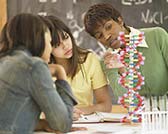
Women and African Americans have made major gains in social position in the U.S., but racial and gender disparities in STEM occupations remain persistent. A U.S. Department of Commerce 2011 report notes that while women hold almost half of all jobs in the U.S., they hold just 24% of STEM jobs. A 2013 Census report noted that in 2011 11% of the workforce was black while only 6% of STEM workers were black.
Stearns and colleagues wanted to understand how high school context influences students’ post-high school intentions. In addition, they sought to understand how the racial and gender composition of math and science teachers pre-college might influence students’ choice of college major.
The researchers followed 16,300 college-bound North Carolina public school students from seventh grade through college graduation and analyzed how the racial and gender makeup of the teacher population in middle and high schools affected students’ major declaration and degree field. They found that a greater proportion of female math and science teachers increased the probability that a young woman declares a STEM major and graduates with a STEM degree. This relationship did not exist for men or for African American students.
So, in other words, female teachers in science and math can transcend traditional associations between success in those fields and masculinity, and may push girls to challenge these stereotypes. For young women who pursue STEM degrees, pre-college experiences are an important influence on career aspirations.
You can read the full article here:
Elizabeth Stearns,, Martha Cecilia Bottía, Eleonora Davalos, Roslyn Mickelson, Stephanie Moller, & Lauren Valentino. (2016). Demographic Characteristics of High School Math and Science Teachers and Girls’ Success in STEM. Social Problems, 63(1), 87-110.




Comments